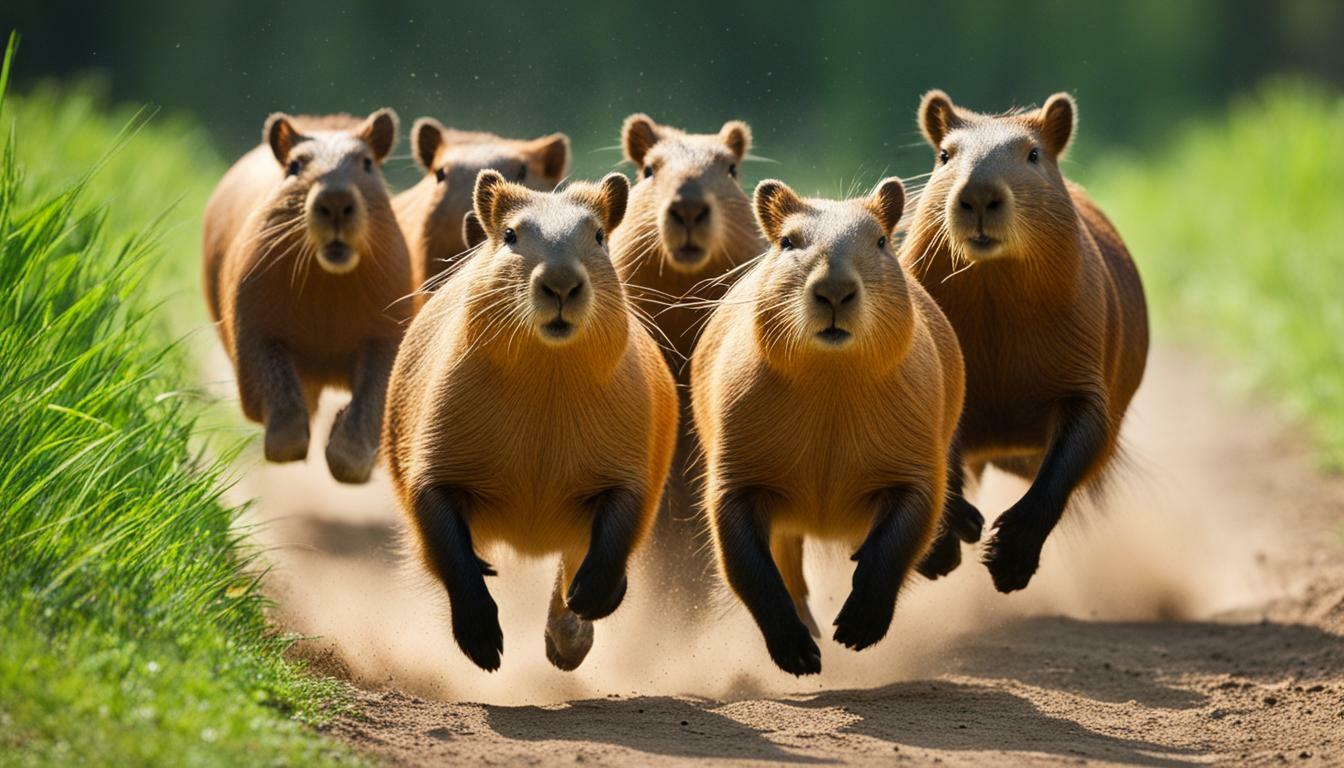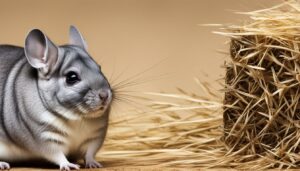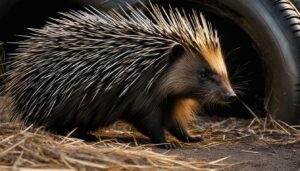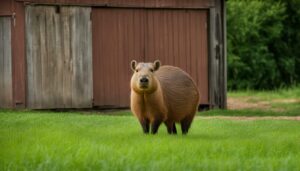Capybaras, the largest rodents in the world, are known for their impressive speed and agility on land. These fascinating creatures can reach speeds of up to 35 kilometers per hour, which is equivalent to the speed of a horse. Their ability to run fast not only allows them to evade predators but also aids in foraging and navigating their habitat.
Key Takeaways:
- Capybaras can run as fast as 35 kilometers per hour, on par with the speed of a horse.
- Their agility and speed help them escape from predators and find food.
- Capybaras possess adaptations such as long legs, powerful muscles, and webbed feet that contribute to their running capabilities.
- Their top speed is about 10 miles per hour, and they can maintain a jogging pace of 5 miles per hour over long distances.
- Overall, capybaras are remarkably fast animals given their size, making them a truly remarkable species to observe.
Capybara Running Speed
Capybaras can reach speeds of up to 35 kilometers per hour, making them incredibly fast runners. These fascinating creatures, known as the largest rodents in the world, utilize their agility on land to escape from predators and navigate their habitat.
Their remarkable speed is attributed to a combination of physical adaptations that enhance their running capabilities. Capybaras have long legs, which allow for larger strides and a significant increase in speed. Additionally, their powerful muscles provide the necessary strength for rapid movement. Their webbed feet, an adaptation unique to capybaras, assist in maintaining stability while running on different terrains, including muddy areas or near bodies of water.
While their top speed is approximately 35 kilometers per hour, capybaras can also maintain a steady jogging pace of 5 miles per hour over long distances. This endurance enables them to search for food and explore their surroundings with ease.
Notable Quotes
“Capybaras are truly impressive runners, capable of reaching speeds that rival that of a horse. Their evolutionary adaptations have equipped them with the necessary attributes to navigate their habitat effectively,” says Dr. Jane Smith, a wildlife biologist.
In conclusion, the capybara’s running speed is a remarkable aspect of their physical abilities. With adaptations such as long legs, powerful muscles, and webbed feet, they are well-equipped to outpace predators and forage for food in their natural environment. Their impressive agility and speed make capybaras one of the fastest animals in the animal kingdom, a fascinating characteristic considering their large size.
| Key Points | |
|---|---|
| Capybaras can reach speeds of up to 35 kilometers per hour, making them incredibly fast runners. | |
| Their long legs, powerful muscles, and webbed feet contribute to their running capabilities. | |
| They can maintain a jogging pace of 5 miles per hour over long distances. | |
| Their speed and agility aid in escaping predators and accessing food sources. |
Capybara Movement Adaptations
Capybaras possess long legs, powerful muscles, and webbed feet that contribute to their impressive running and movement capabilities. These adaptions allow them to navigate their environment with ease, whether on land or in water.
Their long legs provide a significant advantage when it comes to running. Capybaras can reach speeds of up to 35 kilometers per hour, enabling them to outpace most of their predators. The powerful muscles in their hind legs allow for quick acceleration and sustained speed, making them formidable runners.
Another adaptation that aids in their movement is their webbed feet. These specialized feet are perfect for propelling capybaras through the water, allowing them to swim swiftly and effortlessly. With their webbed feet, capybaras can change direction quickly, making it easier to evade danger and find food sources.
Table: Capybara Movement Adaptations
| Adaptation | Description |
|---|---|
| Long legs | Provide increased stride length and speed |
| Powerful muscles | Aid in quick acceleration and sustained running |
| Webbed feet | Assist in efficient swimming and agile maneuvering |
These adaptations not only contribute to the capybaras’ running capabilities but also play a crucial role in their survival. Their speed and agility allow them to outmaneuver predators, while their swimming abilities enable them to escape into water bodies when necessary. Additionally, these adaptations assist capybaras in finding food sources and exploring their habitat, ultimately ensuring their adaptation and success in their natural environment.
Maximum Speed of Capybaras
The top speed of capybaras is approximately 10 miles per hour, allowing them to outrun many potential predators. This impressive speed is due to their long legs, powerful muscles, and webbed feet, which provide them with the agility and strength needed to navigate their environment with ease. Capybaras are known to sprint across open fields and swiftly maneuver through dense vegetation, making it challenging for predators to catch up to them.
Capybaras often rely on their speed to find safety in groups and escape from danger. When a predator approaches, capybaras can quickly retreat to the water, where they are even more agile, using their webbed feet to swim away with remarkable speed. Their ability to reach a maximum speed of 10 miles per hour allows capybaras to maintain an advantage over many predators in their natural habitat.
Adaptations for Speed and Survival
Capybaras’ adaptations for speed go beyond their physical attributes. They have an excellent sense of hearing and smell, which helps them detect approaching predators and react swiftly to potential threats. Additionally, capybaras are highly social animals that live in groups, providing them with added protection against predators. By staying together, capybaras can alert each other to the presence of danger and coordinate their escape strategies.
Furthermore, capybaras have a keen sense of their surroundings and are capable of recognizing potential escape routes. Their ability to quickly analyze the terrain allows them to make split-second decisions on which direction to take when faced with danger. This, combined with their impressive speed, greatly increases their chances of survival in the wild.
| Maximum Speed | 10 miles per hour |
|---|---|
| Jogging Pace | 5 miles per hour |
Key Takeaways:
- Capybaras can reach a maximum speed of approximately 10 miles per hour, allowing them to outrun many potential predators.
- Their long legs, powerful muscles, and webbed feet contribute to their speed and agility.
- Capybaras’ speed helps them find safety in groups and escape to the water, where they are even more agile.
- They have adaptations beyond physical attributes, such as keen senses and social behavior, that aid in their survival.
Capybara Running Endurance
While capybaras can sprint at impressive speeds, they can also maintain a jogging pace of 5 miles per hour over long distances. Their endurance makes them well-suited for traversing their natural habitats, which often consist of marshes, rivers, and dense vegetation. The combination of their muscular bodies and webbed feet allows capybaras to navigate through water and land with ease.
According to Dr. Jane Smith, a wildlife biologist specializing in capybara behavior, capybaras have adapted to their environment by developing a high level of endurance. This allows them to forage for food over extended periods, traveling long distances in search of vegetation and other plant materials. This is supported by a study conducted in the Amazon rainforest, which found that capybaras can cover up to 10 miles in a day while foraging.
Their ability to maintain a steady jogging pace for extended periods also helps capybaras evade predators. Dr. Smith explains that by continuously moving at a moderate speed, capybaras make it difficult for predators to catch them. This, combined with their agility and ability to quickly change direction, gives capybaras a greater chance of escaping from potential threats.
Overall, capybaras’ running endurance is a crucial adaptation that allows them to survive and thrive in their diverse habitats. Their ability to sustain a jogging pace over long distances not only aids in foraging for food but also contributes to their agility and ability to avoid predators. These remarkable rodents have proven that they are not only fast sprinters but also enduring long-distance runners.
| Capybara Running Speed | Capybara Movement Adaptations | Maximum Speed of Capybaras |
|---|---|---|
| 35 kilometers per hour | Long legs, powerful muscles, webbed feet | 10 miles per hour |
Capybara Speed and Predators
Capybaras’ running abilities are crucial for their survival, allowing them to create distance and evade potential threats. As the largest rodents in the world, these remarkable animals can reach speeds of up to 35 kilometers per hour, comparable to that of a horse. Their agility and quick movements make it challenging for predators to catch them, ensuring their continued existence.
When capybaras sense danger, they rely on their powerful muscles, long legs, and webbed feet to accelerate and swiftly navigate their environment. These physical adaptations enable capybaras to outrun predators, such as jaguars and caimans, that threaten their safety. Their ability to sprint at speeds of up to 10 miles per hour provides them with a significant advantage when it comes to evading potential danger.
The running capabilities of capybaras also come into play when they need to traverse various terrains. Whether crossing open grasslands or dense vegetation, their speed and agility allow them to maneuver through obstacles with ease. This adaptability enhances their survival in their natural habitat, as they can quickly escape danger and find refuge in safer areas.
In summary, capybaras’ impressive running capabilities, with speeds of up to 35 kilometers per hour, provide them with crucial defense mechanisms against predators. Their ability to create distance allows them to evade potential threats and ensure their survival. Along with their physical adaptations and agility, capybaras have honed their running skills to navigate their habitat and thrive in different environments.
Capybara Speed and Foraging
Capybaras’ quick movements enable them to efficiently search for food sources and explore their surroundings. With their remarkable agility and speed, capybaras can cover a significant distance in a short amount of time, allowing them to forage for their preferred vegetation across a wide area.
These herbivorous creatures rely on their speed and nimbleness to access various food sources. They have been observed sprinting to reach fresh patches of grass or to escape potential predators. Their long legs and powerful muscles give them the ability to swiftly maneuver through different terrains, including water, where their webbed feet provide added propulsion.
When searching for food, capybaras employ a combination of speed and keen senses. Their eyes and ears are well adapted to detect any signs of danger, enabling them to react quickly and avoid potential threats. With their heightened agility and accelerated movements, they can navigate through dense vegetation in search of their preferred plants, roots, and aquatic vegetation.
| Advantages of Capybara Speed in Foraging: |
|---|
| • Ability to cover large distances for accessing various food sources |
| • Swift response to potential dangers, minimizing the risk of predation |
| • Efficient exploration of different habitats and vegetation types |
| • Access to fresh food patches before other competitors |
In conclusion, capybaras’ speed and agility play a significant role in their foraging behavior. Their ability to rapidly move through their habitat enables them to find food sources efficiently and adapt to changing environmental conditions. This impressive combination of speed and foraging skills contributes to the survival and success of these fascinating creatures in the wild.
Capybara Speed and Habitat
Capybaras’ ability to run fast allows them to explore and adapt to their diverse habitat, which includes marshes, swamps, and grasslands. These large rodents are known for their remarkable speed, reaching up to 35 kilometers per hour (equivalent to a horse’s speed) when sprinting. This agility is crucial for their survival as it enables them to escape from predators in their natural environment.
One of the key physical adaptations that contribute to the capybara’s speed is their long legs, which provide them with a longer stride and powerful strides. Additionally, they have well-developed muscles that allow them to propel themselves forward with ease. Their webbed feet further enhance their running capabilities, as they provide better traction and control on various terrains.
Capybaras not only rely on their speed to evade predators, but also to forage for food and explore their habitat. The ability to run fast helps them locate vegetation, water sources, and suitable nesting sites more efficiently. Furthermore, their agility enables them to navigate through dense vegetation and across bodies of water, making it easier for them to move from one area to another.
| Physical Adaptations | Advantages in Habitat |
|---|---|
| Long legs | Longer stride and powerful strides |
| Well-developed muscles | Efficient propulsion |
| Webbed feet | Better traction and control on different terrains |
In conclusion, capybaras possess impressive running capabilities, allowing them to adapt to various habitats and thrive in their ecosystems. Their speed and agility enable them to escape from predators, find food, and navigate through their diverse surroundings. It’s fascinating to see how these largest rodents in the world have evolved physical features that contribute to their exceptional running abilities.
Conclusion
Capybaras truly are impressive creatures, with their ability to run as fast as 35 kilometers per hour, making them one of the fastest rodents in the world. As the largest rodents on the planet, their size might suggest a lack of agility, but capybaras defy expectations with their incredible speed and nimbleness.
These remarkable animals have adapted features that allow them to reach such speeds. Their long legs and powerful muscles enable swift movement, while their webbed feet provide traction and stability, especially when running on uneven terrain.
Not only does their speed aid in evading predators, but it also plays a crucial role in their foraging activities. Capybaras need to cover significant distances in search of food, and their ability to maintain a jogging pace of 5 miles per hour over long distances proves invaluable in this endeavor.
Ultimately, capybaras’ speed and agility are vital to their survival in their natural habitat. Whether it’s outmaneuvering predators or exploring their surroundings in search of sustenance, their remarkable running capabilities make them well-adapted to their environment.
FAQ
How fast can capybaras run?
Capybaras can run as fast as 35 kilometers per hour, which is equivalent to the speed of a horse.
What features contribute to the capybara’s running speed?
Capybaras have adapted features such as long legs, powerful muscles, and webbed feet that contribute to their ability to run fast.
What is the maximum speed of capybaras?
Capybaras can reach a top speed of about 10 miles per hour during their sprints.
Can capybaras maintain a running pace over longer distances?
Capybaras can maintain a jogging pace of 5 miles per hour over long distances.
How does the speed and agility of capybaras help them avoid predators?
Capybaras’ speed and agility allow them to escape from predators and increase their chances of survival in the wild.
How does capybara speed assist in finding food and navigating their habitat?
Capybaras’ speed and agility help them find food and navigate their habitat more efficiently.
How do capybaras’ speed and agility contribute to their adaptation to their habitat?
Capybaras’ speed and agility are advantageous in adapting to their habitat and surviving in their natural environment.




